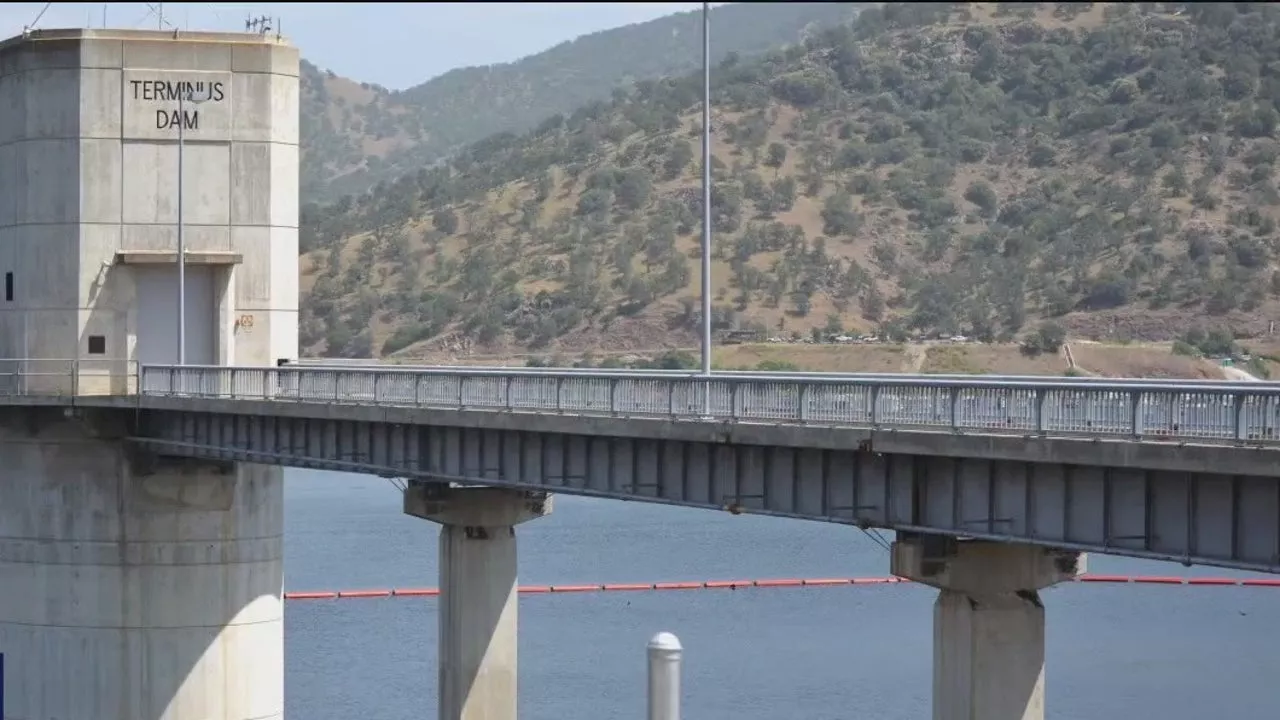President Trump's order to release billions of gallons of water from California reservoirs has drawn criticism for potentially harming local farmers and being ineffective in addressing wildfire concerns.
President Donald Trump directed the Army Corps of Engineers to release billions of gallons of water from two reservoirs in California's Central Valley over 100 miles from the wildfire zones, a decision that has stunned residents. Newsweek reached out to California Governor Gavin Newsom's office via email for comment.
This move comes after water shortages were allegedly reported to have hampered firefighting efforts in Los Angeles during the devastating wildfires, a claim that state officials deny, arguing that the hydrants went dry because of the high local demand. Since then, Trump has been highly critical of California authorities, calling on Governor Gavin Newsom to resign and dubbing him 'Newscum' on social media, and falsely blaming water shortages during the response on California's water management policies. He's also threatened to withhold disaster aid unless California goes along with his moves to deliver more water.Trump's latest action, which overrides California's water policies, could hit local farmers hard. After an executive order signed by Trump last week, 2.2 billion gallons of water in two reservoirs in the southern Sierra Nevada's foothills were released on Friday. That water was discharged into the dry lake bed of Tulare Lake in the San Joaquin Valley, according to a letter from Senator Alex Padilla to Secretary of Defense Pete Hegseth. It happened four days after President Trump said on social media that the U.S. military had 'entered' California and 'TURNED ON THE WATER.' State authorities denied this at the time. During a visit to Los Angeles last week, Trump also vowed to 'open up the valves and pumps' in California to deliver more water. Experts and local farmers have argued that the newly released water is being wasted by being released during the wet winter season. These kinds of shenanigans, they hurt smaller farmers,' Dezaraye Bagalayos, a local water activist, told the Los Angeles Times. Small growers have already been struggling, and the release of water from the dams means they will have less when they need it, Bagalayos said. 'The last thing in the world California water management needs is somebody like Trump calling shots when he doesn't know how anything works,' Bagalayos said. 'It's making an already hard situation very, very difficult. We don't have a lot of wiggle room in the state of California to be messing around with our water supply like this.' The two reservoirs hold supplies for agricultural irrigation districts, meaning San Joaquin Valley farmers rely on the dams for summer irrigation. Releasing water now when it's not needed means less will be available during one of the area's driest years on record. Meanwhile, the water releases caused a slight drop in reservoir levels. Lake Success, near Porterville, decreased from about 20 percent full to 18 percent, while Lake Kaweah, near Visalia, fell from roughly 21 percent to 19 percent of capacity over the weekend. Tom Barcellos, president of the Lower Tule River Irrigation District and a dairyman and farmer, also expressed anger at Trump's order, telling the Los Angeles Times: 'It would have been better utilized if we could keep it there and use it this summer for irrigation.' 'I believe someone in D.C. got a little overzealous,' he said. Experts have also argued that the water will not flow to Los Angeles and, therefore, won't help extinguish the wildfires. Climate and hydrology expert Peter Gleick told CBS: 'There is absolutely no connection between this water and the water needed for firefighting in L.A. There's no physical connection. There's no way to move the water from where it is to the Los Angeles basin.' Laura Ramos, interim director of research and education at the California Water Institute at California State University, Fresno, told the Los Angeles Times: 'If the purpose was to help with the fires in Southern California, we do not believe that it will because that's not where that water goes.' However, Matt Hurley, general manager of the McMullin Area Groundwater Sustainability Agency, told the Los Angeles Times that while the order won't help the Los Angeles fires, it may still have a positive impact. Los Angeles heavily relies on groundwater and winter precipitation stored in state reservoirs to irrigate crops. 'Will it help L.A.'s fire? No, absolutely not. But it will help groundwater,' Hurley said. 'From a groundwater manager's point of view, getting any water in the ground is better than nothing.' Heather Cooley, director of research for California water policy organization at the Pacific Institute, told CNN: 'They were holding extra water in those reservoirs because of the risk that it would be a dry summer. This puts agriculture at risk of insufficient water during the summer months.' 'This release is extremely concerning,' Cooley added. 'It's providing zero benefit and putting California farmers at risk of water supply constraints in the coming months.
CALIFORNIA WILDFIRES TRUMP ADMINISTRATION WATER MANAGEMENT FARMERS ENVIRONMENTAL ISSUES
United States Latest News, United States Headlines
Similar News:You can also read news stories similar to this one that we have collected from other news sources.
 Trump Administration Bypasses California Authorities, Releases Water from Dams Amid WildfiresFacing criticism for his handling of the California wildfires, President Trump's administration released significant amounts of water from California's dams, bypassing state authorities. This move, aimed at 'maximizing' water deliveries in California, has sparked controversy and raised concerns among local officials about potential flooding.
Trump Administration Bypasses California Authorities, Releases Water from Dams Amid WildfiresFacing criticism for his handling of the California wildfires, President Trump's administration released significant amounts of water from California's dams, bypassing state authorities. This move, aimed at 'maximizing' water deliveries in California, has sparked controversy and raised concerns among local officials about potential flooding.
Read more »
 Trump's Unscheduled Water Releases in California Spark Controversy and ConcernsPresident Trump's decision to release water from two dams in California's Central Valley has ignited debate and raised safety concerns. While Trump claims the move will benefit the entire state, including Southern California, experts say the released water is not connected to the region and could not have aided wildfire suppression efforts.
Trump's Unscheduled Water Releases in California Spark Controversy and ConcernsPresident Trump's decision to release water from two dams in California's Central Valley has ignited debate and raised safety concerns. While Trump claims the move will benefit the entire state, including Southern California, experts say the released water is not connected to the region and could not have aided wildfire suppression efforts.
Read more »
 ‘That’s peanuts:’ Trump says about billions of returns on $TRUMP memecoin‘That’s peanuts:’ Trump says about billions of returns on $TRUMP memecoin
‘That’s peanuts:’ Trump says about billions of returns on $TRUMP memecoin‘That’s peanuts:’ Trump says about billions of returns on $TRUMP memecoin
Read more »
 California Wildfires Expected to Cost State BillionsThe devastating wildfires sweeping through Southern California are projected to inflict the highest economic and insured losses in the state's history, according to a new analysis by JPMorgan. The fires have claimed at least five lives and caused widespread destruction, impacting nearly 30,000 acres and threatening over 15,000 homes and buildings.
California Wildfires Expected to Cost State BillionsThe devastating wildfires sweeping through Southern California are projected to inflict the highest economic and insured losses in the state's history, according to a new analysis by JPMorgan. The fires have claimed at least five lives and caused widespread destruction, impacting nearly 30,000 acres and threatening over 15,000 homes and buildings.
Read more »
 California Wildfires Expected to Be Costliest in State's History, Leaving Insurers Facing Billions in LossesThe devastating wildfires raging across Southern California are projected to inflict the highest financial losses on insurers in the state's history. Fuelled by strong Santa Ana winds, the fires have already claimed at least 24 lives, burned 40,000 acres, and destroyed over 12,000 structures. Both JPMorgan and Wells Fargo estimate insured losses could exceed $20 billion, with Wells Fargo placing the figure as high as $30 billion. This would surpass the $10 billion losses incurred from the 2018 Camp Fire. Moody's Ratings analysis reveals State Farm holds the largest share of homeowners insurance premiums in California, followed by Farmers Insurance. The impact on the insurance industry is significant, with some insurers withdrawing from fire-prone areas and increasing premiums to offset the risk.
California Wildfires Expected to Be Costliest in State's History, Leaving Insurers Facing Billions in LossesThe devastating wildfires raging across Southern California are projected to inflict the highest financial losses on insurers in the state's history. Fuelled by strong Santa Ana winds, the fires have already claimed at least 24 lives, burned 40,000 acres, and destroyed over 12,000 structures. Both JPMorgan and Wells Fargo estimate insured losses could exceed $20 billion, with Wells Fargo placing the figure as high as $30 billion. This would surpass the $10 billion losses incurred from the 2018 Camp Fire. Moody's Ratings analysis reveals State Farm holds the largest share of homeowners insurance premiums in California, followed by Farmers Insurance. The impact on the insurance industry is significant, with some insurers withdrawing from fire-prone areas and increasing premiums to offset the risk.
Read more »
 California Lawmakers Propose E15 Fuel Blend to Slash Gas Prices and Save BillionsAssembly Bill 30 aims to require the California Air Resources Board to approve the use of E15 fuel, a cheaper alternative already authorized in all other states, which could save California drivers billions of dollars annually.
California Lawmakers Propose E15 Fuel Blend to Slash Gas Prices and Save BillionsAssembly Bill 30 aims to require the California Air Resources Board to approve the use of E15 fuel, a cheaper alternative already authorized in all other states, which could save California drivers billions of dollars annually.
Read more »
